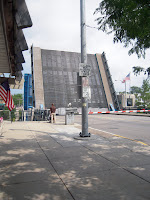Today was the last day of my externship. I’m going to miss Dr. Stewart, his family and the office. Over the past two weeks, I’ve spent the majority of my time shadowing in the clinic, although I did spend a few days in the ER with Dr. Smith and Dr. Joy. What I loved most about rural medicine was the relationships that physicians build with their patients. That may sound super cliché, but compared to prior shadowing experiences, I have not a single physician who knows as much about his patients as Dr. Stewart does. Usually when I shadow, I hear about the patient’s medical history, strictly medical, before seeing a patient. Not only does he know everything, medical and non-medical about his patients, but he also knows about his patients’ relationships with their husbands/wives/boyfriends/girlfriends/siblings/children/parents. Literally. He’s also delivered two generations of people here in Charlevoix. So, it is not such a far-fetched question to ask if he has delivered the 40-year-old patient in room 2.
What else did I love? The variety. If you see my addendum to my first post, you’ll see how diverse this practice is. This is the kind of practice and knowledge I hope to have after practicing for many years. I never really considered specializing in anything, but after this experience, I really doubt that I will specialize. How cool would it be, to have the knowledge that allows me to take care of a person from birth to death? That requires an enormous amount of practice and skill. A physician would need to keep updated on all kinds of information involving every aspect of the body. He or she would also have to read a variety of journals and cannot settle for reading a few and focus solely on one organ. I apologize if it sounds like I am attacking specialists; I am not. I just think that family practice is undervalued and that family practice physicians deserve a lot more credit than we give them.
I am immensely grateful that I was able to shadow Dr. Stewart and his partners for these two weeks. Dr. Stewart, especially, is an amazing teacher- he really involved me in every with every single patient and taught me many different techniques and tests that gave me more confidence in myself and that will prove useful in med school, I’m sure.
-----
After one last day of seeing patients in the clinic, we sat down in his office and he showed me some prescriptions, written in the time of dinosaurs, i.e. the pre-1960s. In this time, medications were not made using standardized methods- the doctor would tell the pharmacist how to make a medication and then, the pharmacist would prepare the medication, from scratch, in the lab. Take a look at the prescription, dated September 21, 1936, below:
The doctor and patient’s names have been covered up in accordance with HIPPA regulations. On the first line, the doctor has ordered 40 grains of Acid Acetylsalicylic acid. This should sound familiar to you if you took Orgo 1 lab- this is just Tylenol. On the third line, notice that the doctor prescribed Phenobarbital, which used to be used as a sleep medication. The fourth line reads 2.5 grains of Essence of Belladonna- to make this, the pharmacist would physically extract the essence from the Belladonna leaves in his lab.
Before the 1960s, medical students had to take a course where they would learn the components of drugs and how to make medications. After the government required medicine to be manufactured in a uniform matter however, this course was dropped from the curriculum.
------
One last thing, Dr. Tinney, the pediatrician that shares the building with Pine River Medical took me up on his plane. And I did indeed fly it for a little while! Flying is a lot more difficult than Dr. Tinney made it seem; I kept overturning or underturning. Here are some pictures:
 |
| The plane- seats 6. |
 |
| Dr. Tinney sat on the left, and I on the right |
 |
| That little red dot on the smaller peninsula is the lighthouse that Charlevoix is famous for. |
 |
| Dr. Tinney and I |
-----
Thank you again everyone: Dr. Stewart, Kate, Dr. Joy, Dr. Mann, Christina, Wendy, Sue, Dr. Tinney, Amy, Regina, Connie, Dr. Brown, Dr. and Mrs. Newcombe, Dr. Smith, Dr. Ivey, Michelle, Donna, Sue, Chris, Jean, Betty. This was an amazing experience :)





















